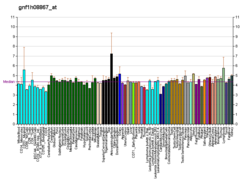Desert hedgehog (protein)
| DHH | |||||||||||||||||||||||||||||||||||||||||||||||||||
|---|---|---|---|---|---|---|---|---|---|---|---|---|---|---|---|---|---|---|---|---|---|---|---|---|---|---|---|---|---|---|---|---|---|---|---|---|---|---|---|---|---|---|---|---|---|---|---|---|---|---|---|
 | |||||||||||||||||||||||||||||||||||||||||||||||||||
| |||||||||||||||||||||||||||||||||||||||||||||||||||
| Identifiers | |||||||||||||||||||||||||||||||||||||||||||||||||||
| Aliases | DHH, GDXYM, HHG-3, SRXY7, C78960, desert hedgehog, desert hedgehog signaling molecule, GDMN | ||||||||||||||||||||||||||||||||||||||||||||||||||
| External IDs | OMIM: 605423; MGI: 94891; HomoloGene: 22431; GeneCards: DHH; OMA:DHH - orthologs | ||||||||||||||||||||||||||||||||||||||||||||||||||
| |||||||||||||||||||||||||||||||||||||||||||||||||||
| |||||||||||||||||||||||||||||||||||||||||||||||||||
| |||||||||||||||||||||||||||||||||||||||||||||||||||
| |||||||||||||||||||||||||||||||||||||||||||||||||||
| Wikidata | |||||||||||||||||||||||||||||||||||||||||||||||||||
| |||||||||||||||||||||||||||||||||||||||||||||||||||
| desert hedgehog | |||||||
|---|---|---|---|---|---|---|---|
| Identifiers | |||||||
| Symbol | DHH | ||||||
| Alt. symbols | HHG-3, MGC35145 | ||||||
| NCBI gene | 50846 | ||||||
| HGNC | 2865 | ||||||
| OMIM | 605423 | ||||||
| RefSeq | NM_021044 | ||||||
| UniProt | O43323 | ||||||
| Other data | |||||||
| Locus | Chr. 12 q13.1 | ||||||
| |||||||
Desert hedgehog, also Desert hedgehog homolog or DHh, is a protein encoded by the DHH gene, and is a member of the hedgehog signaling pathway. The human homolog (DHH) is on chromosome band 12q13.1.[5][6] The protein encoded by this gene is involved in cell signaling. The several mammalian variants of the Drosophila hedgehog gene (which was the first named) have been named after the various species of hedgehog; the desert hedgehog is honored by this one. The gene is not specific to desert hedgehogs. The Desert Hedgehog gene has been identified in both humans and mouse models. [7]
Function
[edit]This gene encodes a member of the hedgehog family. The hedgehog gene family encodes signaling molecules that play an important role in regulating morphogenesis. This protein is predicted to be made as a precursor that is autocatalytically cleaved; the N-terminal portion is soluble and contains the signalling activity while the C-terminal portion is involved in precursor processing. More importantly, the C-terminal product covalently attaches a cholesterol moiety to the N-terminal product, restricting the N-terminal product to the cell surface and preventing it from freely diffusing throughout the organism.
The hedgehog signaling pathway allows for signal transmission between cell membranes and the nucleus. While Dhh is mostly inactive in adults, this gene plays an important role in embryonic development. While Drosophila, the species this gene was discovered in, has only been shown to have one Hedgehog gene, three different genes in the Hedgehog family have been identified in vertebrates. These genes are Sonic Hedgehog (SHh), Indian Hedgehog (IHh), and Desert Hedgehog (DHh). [8]
The expression of DHh is mostly limited to the gonadal cells. More specifically, this gene is commonly identified within the sertoli cells of the testes. This gene plays a large role in the cell differentiation within these germ cells.[8][9]
Clinical significance
[edit]Defects in this protein have been associated with partial gonadal dysgenesis (PGD) accompanied by minifascicular polyneuropathy. This protein may be involved in both male gonadal differentiation and perineurial development.[10]
The presence of DHh in sertoli cells allows for proper testicular development and differentiation of the germ cells within the testes. Blocking the DHh signaling throughout testes development results in disrupted spermatogenesis along with infertility. Mutations in DHh expression result in infertility, likely due to the blockage of the cell differentiation process. [9]
Animal Models
[edit]Mouse models show very serious effects are a result of both a repression and an overexpression of DHh. Mutant mice with a DHh expression deficiency show malformations and growth restriction in the Central Nervous System, skeletal, limb, and craniofacial structural development. Additionally, persistent high levels of DHh expression have been connected with tumor development in organ tissues of postnatal mice. [7]
References
[edit]- ^ a b c GRCh38: Ensembl release 89: ENSG00000139549 – Ensembl, May 2017
- ^ a b c GRCm38: Ensembl release 89: ENSMUSG00000023000 – Ensembl, May 2017
- ^ "Human PubMed Reference:". National Center for Biotechnology Information, U.S. National Library of Medicine.
- ^ "Mouse PubMed Reference:". National Center for Biotechnology Information, U.S. National Library of Medicine.
- ^ Kamisago M, Kimura M, Furutani Y, Furutani M, Takao A, Momma K, Matsuoka R (1999). "Assignment of human desert hedgehog gene (DHH) to chromosome band 12q13.1 by in situ hybridization". Cytogenet. Cell Genet. 87 (1–2): 117–8. doi:10.1159/000015376. PMID 10640830. S2CID 2152329.
- ^ Tate G, Satoh H, Endo Y, Mitsuya T (2000). "Assignment of desert hedgehog (DHH) to human chromosome bands 12q12→q13.1 by in situ hybridization". Cytogenet. Cell Genet. 88 (1–2): 93–4. doi:10.1159/000015495. PMID 10773676. S2CID 36364525.
- ^ a b Sasai, Noriaki; Toriyama, Michinori; Kondo, Toru (2019-11-08). "Hedgehog Signal and Genetic Disorders". Frontiers in Genetics. 10: 1103. doi:10.3389/fgene.2019.01103. ISSN 1664-8021. PMC 6856222. PMID 31781166.
- ^ a b Skoda, Ana Marija; Simovic, Dora; Karin, Valentina; Kardum, Vedran; Vranic, Semir; Serman, Ljiljana (2018-02-20). "The role of the Hedgehog signaling pathway in cancer: A comprehensive review". Bosnian Journal of Basic Medical Sciences. 18 (1): 8–20. doi:10.17305/bjbms.2018.2756. ISSN 1840-4812. PMC 5826678. PMID 29274272.
- ^ a b Mäkelä, Juho-Antti; Saario, Vuokko; Bourguiba-Hachemi, Sonia; Nurmio, Mirja; Jahnukainen, Kirsi; Parvinen, Martti; Toppari, Jorma (November 2011). "Hedgehog signalling promotes germ cell survival in the rat testis". Reproduction. 142 (5): 711–721. doi:10.1530/REP-11-0110. ISSN 1470-1626. PMC 3207727. PMID 21893610.
- ^ "Entrez Gene: desert hedgehog homolog (Drosophila)".
External links
[edit]- DHH protein, human at the U.S. National Library of Medicine Medical Subject Headings (MeSH)
This article incorporates text from the United States National Library of Medicine, which is in the public domain.





